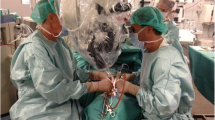Abstract
A head skin incision is inevitable in neurosurgical procedures and is usually concealed within the hairline. Androgenetic alopecia (AGA) is a progressive hair loss disorder or baldness highly prevalent in men. Therefore, if bald male patients require neurosurgical procedures, skin incisions cannot be concealed, but this subject is yet to be discussed in the literature. This study presents a frontotemporal craniotomy using a skin incision along the superior temporal line, ignoring the hairline in bald male patients. Thirty-three patients with temporal gliomas underwent surgical removal between 2015 and 2022. They were divided into three groups: bald male patients with skin incisions not concealed in the hairline (minimum group, n = 13), bald and non-bald male patients with skin incisions concealed in the hairline (male group, n = 11), and female patients with skin incisions concealed in the hairline (female group, n = 9). In the minimum group, patients had no complaints regarding the incision scar. Cosmetic outcome was excellent, and no cases showed surgical site infection or peripheral facial nerve palsy. Compared with the male and female groups, the minimum group had the shortest skin incision length; however, the craniotomy size and extent of resection were similar. Skin incision for frontotemporal craniotomy cannot be hidden in bald male patients, and the preferred location for the incision is unknown. The skin incision along the superior temporal line is a cosmetically favorable, feasible, and safe procedure.





Similar content being viewed by others
Data availability
Dataset may be available upon request.
References
Lolli F, Pallotti F, Rossi A et al (2017) Androgenetic alopecia: a review. Endocrine 57:9–17. https://doi.org/10.1007/s12020-017-1280-y
Otberg N, Finner AM, Shapiro J (2007) Androgenetic alopecia. Endocrinol Metab Clin North Am 36:379–398. https://doi.org/10.1016/j.ecl.2007.03.004
Altay T, Couldwell WT (2012) The frontotemporal (pterional) approach: an historical perspective. Neurosurgery 71:481–491. https://doi.org/10.1227/NEU.0b013e318256c25a. (discussion 491-482)
Ishino A, Uzuka M, Tsuji Y, Nakanishi J, Hanzawa N, Imamura S (1997) Progressive decrease in hair diameter in Japanese with male pattern baldness. J Dermatol 24:758–764. https://doi.org/10.1111/j.1346-8138.1997.tb02321.x
Ishino A, Takahashi T, Suzuki J, Nakazawa Y, Iwabuchi T, Tajima M (2014) Contribution of hair density and hair diameter to the appearance and progression of androgenetic alopecia in Japanese men. Br J Dermatol 171:1052–1059. https://doi.org/10.1111/bjd.13230
Cai M, Ye Z, Ling C, Zhang B, Hou B (2019) Trans-eyebrow supraorbital keyhole approach in suprasellar and third ventricular craniopharyngioma surgery: the experience of 27 cases and a literature review. J Neurooncol 141:363–371. https://doi.org/10.1007/s11060-018-03041-7
Poblete T, Jiang X, Komune N, Matsushima K, Rhoton AL Jr (2015) Preservation of the nerves to the frontalis muscle during pterional craniotomy. J Neurosurg 122:1274–1282. https://doi.org/10.3171/2014.10.JNS142061
Norwood OT (1975) Male pattern baldness: classification and incidence. South Med J 68:1359–1365. https://doi.org/10.1097/00007611-197511000-00009
Garcia-Garcia S, Gonzalez-Sanchez JJ, Kakaizada S, Lawton MT, Benet A (2020) Facial nerve preservation for supraorbital approaches: anatomical mapping based on consistent landmarks. Oper Neurosurg (Hagerstown) 18:52–59. https://doi.org/10.1093/ons/opz084
Hwang K, Kim YJ, Chung IH (2004) Innervation of the corrugator supercilii muscle. Ann Plast Surg 52:140–143. https://doi.org/10.1097/01.sap.0000095440.20407.0b
Gabrielli MA, Monnazzi MS, Gabrielli MF, Hochuli-Vieira E, Pereira-Filho VA, Mendes Dantas MV (2012) Clinical evaluation of the bicoronal flap in the treatment of facial fractures. Retrospective study of 132 patients. J Craniomaxillofac Surg 40:51–54. https://doi.org/10.1016/j.jcms.2011.01.008
Frati A, Pichierri A, Esposito V et al (2007) Aesthetic issues in neurosurgery: a protocol to improve cosmetic outcome in cranial surgery. Neurosurg Rev 30:69–76. https://doi.org/10.1007/s10143-006-0050-8. (discussion 76-67)
Pankratz J, Baer J, Mayer C, Rana V, Stephens R, Segars L, Surek CC (2020) Depth transitions of the frontal branch of the facial nerve: implications in SMAS rhytidectomy. JPRAS Open 26:101–108. https://doi.org/10.1016/j.jpra.2019.11.009
Son D, Harijan A (2014) Overview of surgical scar prevention and management. J Korean Med Sci 29:751–757. https://doi.org/10.3346/jkms.2014.29.6.751
Monstrey S, Middelkoop E, Vranckx JJ, Bassetto F, Ziegler UE, Meaume S, Teot L (2014) Updated scar management practical guidelines: non-invasive and invasive measures. J Plast Reconstr Aesthet Surg 67:1017–1025. https://doi.org/10.1016/j.bjps.2014.04.011
Goldberg LH, Silapunt S, Alam M, Peterson SR, Jih MH, Kimyai-Asadi A (2005) Surgical repair of temple defects after Mohs micrographic surgery. J Am Acad Dermatol 52:631–636. https://doi.org/10.1016/j.jaad.2004.09.024
Acknowledgements
We thank Editage for the English-language review.
Funding
This work was supported in part by the Japan Society for the Promotion of Science (JSPS) KAKENHI for Grant-in-Aid for Scientific Research (C), Grant Number 22K09291, Taiju Life Social Welfare Foundation, and Parents’ Association Grant of Kitasato University, School of Medicine.
Author information
Authors and Affiliations
Contributions
Y.H., I.S. and T.K. wrote the main manuscript text and prepared figures and tables. All authors collected the data and reviewed the manuscript.
Corresponding author
Ethics declarations
Ethical approval
This retrospective study followed the principles of the Declaration of Helsinki and utilized clinical data approved by the local ethics committees of Kitasato University School of Medicine (IRB#: B22-029).
Consent to participate
Written informed consent was obtained from the participants.
Competing interests
The authors declare no competing interests.
Additional information
Publisher's Note
Springer Nature remains neutral with regard to jurisdictional claims in published maps and institutional affiliations.
Supplementary Information
Below is the link to the electronic supplementary material.
Rights and permissions
Springer Nature or its licensor (e.g. a society or other partner) holds exclusive rights to this article under a publishing agreement with the author(s) or other rightsholder(s); author self-archiving of the accepted manuscript version of this article is solely governed by the terms of such publishing agreement and applicable law.
About this article
Cite this article
Hyakutake, Y., Shibahara, I., Toyoda, M. et al. Frontotemporal craniotomy with skin incision along the superior temporal line outside the hairline in bald male patients with temporal gliomas. Neurosurg Rev 46, 296 (2023). https://doi.org/10.1007/s10143-023-02212-z
Received:
Revised:
Accepted:
Published:
DOI: https://doi.org/10.1007/s10143-023-02212-z




